Marsa Bagoush, CMAUCH
Emad Khalil, CMAUCH

The site of Marsa Bagoush was discovered in 2010 by a group of students from Alexandria University. Archaeological survey of the site by the Alexandria Centre for Maritime Archaeology & Underwater Cultural Heritage started in 2015. The Marsa Bagoush project aimed to survey and document the underwater archaeological remains in the eastern bay of Marsa Bagoush (ancient Zygris). From 2015 to 2017 the eastern bay was surveyed (c. 340,000 m2) and evidence for at least three shipwrecks was identified. The wrecks date back to the Hellenistic, Roman, and Islamic periods.
In 2017 the western bay of Marsa Bagoush (ancient Ladamantia) was explored. It was found to contain extensive evidence for maritime activities including different types of amphorae and the largest collection of ancient anchors found in Egypt outside Alexandria. Accordingly, from 2017 to 2020 an area of c. 480,000 m2 was surveyed and the underwater archaeological material was documented.
The project revealed that ancient Zygris/Ladamantia was one of the largest and most active ancient anchorages along the northern coast of Egypt, which has been in use from at least the 3rd century BC to the early 20th century. Ancient text from the Early Roman Period mentions that the site was a safe harbour that can be accessed in any wind, unlike most anchorages on the NW coast of Egypt. The site was also associated with a network of Roman underground water cisterns which was a major attraction for boats traveling along the Egyptian coastline. The cisterns network was also recorded as part of the project.
The earliest evidence we have are stamped amphora handles (Zenon B) from Knidos (3th century BC), while the latest evidence is an inscription of the name of the British warship HMS Pangbourne, which operated in the Mediterranean in the 1930s. The site also contains the largest collection of ancient anchors recorded so far in Egypt outside Alexandria; thirty-two anchors have been recorded so far.
The project, so far, has surveyed less than half the total area of Marsa Bagoush (c. 3 km2), hence, it is expected that more archaeological remains will be discovered and recorded during the coming seasons.
More information is also available on the CMAUCH website
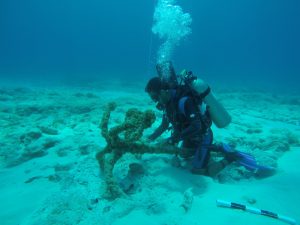 In 2015 permission was obtained from the Egyptian Ministry of Antiquities (MoA) to carry out a preliminary survey of the site in order to evaluate its archaeological potential.
In 2015 permission was obtained from the Egyptian Ministry of Antiquities (MoA) to carry out a preliminary survey of the site in order to evaluate its archaeological potential.
Accordingly, an assessment of the site was carried out by CMAUCH from the 19th to the 25th of July 2015, which revealed that the site has evidence for at least four shipwrecks (early Roman, Late Roman, Late Medieval and 19th century). During the 2015 season, at least three separate clusters of ceramics were discovered along the northern edge of the bay. They extend from east to west and measure 100m X 200m, 50mX50m and 100mX50m respectively. Each of the clusters consists mainly of concreted broken amphorae in addition to other materials such as glass, wood, and glazed pottery.
Moreover, due to its confined nature and shallow depth (max. 12m), the site was identified as being suitable to be utilised for training underwater archaeology students and researchers.
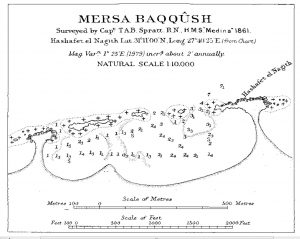 With the kind support of the HFF, the Centre for Maritime Archaeology and Underwater Cultural Heritage of Alexandria University concluded its second season of fieldwork at the site of Marsa Bagoush.
With the kind support of the HFF, the Centre for Maritime Archaeology and Underwater Cultural Heritage of Alexandria University concluded its second season of fieldwork at the site of Marsa Bagoush.
The 2016 season extended form the 12th to the 27th of August during which 124 dives were carried out by a team of graduate students from the Alexandria Centre for Maritime Archaeology & Underwater Cultural Heritage.
The site of Marsa Bagoush, which takes the form of a bay 1000m X 300m, is located 250km west of Alexandria. Marsa Bagoush (ancient Zygris) was mentioned by Claudius Ptolemaeus in the 2nd century AD as one of the harbour sites that extended between Alexandria and Marsa Matrouh (ancient Paraetonium).
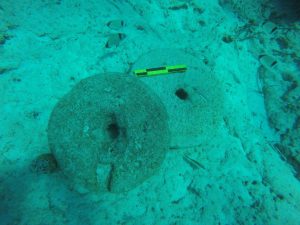
In 1861, as part of a coastal survey of North Africa, the British Royal Navy surveyed the site of Marsa Bagoush and published the first map of the site. In 1968 the Egyptian Oceanographer Anwar Abdel Aleem reported the accidental discovery of some amphorae in the bay of Marsa Bagoush, which he believed to be the remains of an ancient shipwreck. In 1996 the Institute of Nautical Archaeology conducted a limited survey of the site where two intact early Roman amphorae were found and raised. However, no further exploration of the site was made until 2015 when the Alexandria Centre for Maritime Archaeology and Underwater Cultural Heritage started its systematic survey of the site. During the 2015 season, at least three separate clusters of ceramics were discovered along the northern edge of the bay. They extend from east to west and measure 100m X 200m, 50m X 50m and 100m X 50m respectively. Each of the clusters consists mainly of concreted broken amphorae in addition to other materials such as glass, wood and glazed pottery.
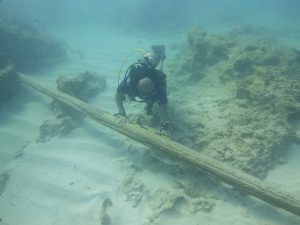 The objective of the 2016 season was to develop 3D models of the main areas that contain concentrations of ceramics within the bay of Marsa Bagoush. Also during this season several areas outside the bay were explored which resulted in the discovery of a new site. Accordingly, at present we have recorded the remains of cargo items from four shipwrecks which date to the Hellenistic, Roman and Islamic periods, as well as the 19th century.
The objective of the 2016 season was to develop 3D models of the main areas that contain concentrations of ceramics within the bay of Marsa Bagoush. Also during this season several areas outside the bay were explored which resulted in the discovery of a new site. Accordingly, at present we have recorded the remains of cargo items from four shipwrecks which date to the Hellenistic, Roman and Islamic periods, as well as the 19th century.
The remains of at least 150 amphorae were recorded inside the bay, the majority of which are Egyptian amphorae from the early Roman period, probably produced in the Mareotic region west of Alexandria. This indicates the existence of at least one shipwreck of that date. The rest of the remains date back to the Late Roman/Islamic period. That is in addition to two grapnel anchors and one admiralty 19th century anchor. Outside the bay, in 13m deep water, several clusters of Egyptian Hellenistic amphora shards were recorded, indicating the existence of a different shipwreck.
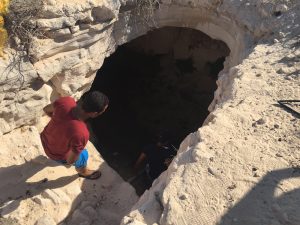 Among the interesting items that were found during this season was a wooden mast that measures 7m. The mast was trapped under rocks at c. 13m deep of water. The mast was located c. 120m to the east of the Hellenistic amphora shards outside the bay. Another unique item was a grinding stone that was found c. 50m north of the same site.
Among the interesting items that were found during this season was a wooden mast that measures 7m. The mast was trapped under rocks at c. 13m deep of water. The mast was located c. 120m to the east of the Hellenistic amphora shards outside the bay. Another unique item was a grinding stone that was found c. 50m north of the same site.
The seabed and archaeological remains were modelled using photogrammetry techniques with the aid of trilateration methods. The 3D models will be used for the study site formation and the distribution of artefacts. It will also be used for presenting the site to the non-diving community.
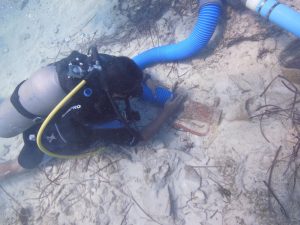 On the other hand? In addition, a preliminary survey was carried out on-land to the south of the shoreline. The survey resulted in the discovery of a series of interconnected rock-cut cisterns which probably date to the Roman Period. The cisterns are solid evidence that the site was occupied in antiquity. During the coming season, excavation of some silted spots inside the bay will be conducted using water dredges in order to expose and record the buried remains. Moreover, fabric analyses of ceramic samples will be carried out to determine its clay type and hence its exact origin. Also a sample of the wooden mask will be collected for dendrochronological dating. More exploration of the deeper water outside the bay will be also carried out. Finally, a management plan of the site will be developed with the objective of preserving its remains in situ and utilising the site as a training facility for underwater archaeology.
On the other hand? In addition, a preliminary survey was carried out on-land to the south of the shoreline. The survey resulted in the discovery of a series of interconnected rock-cut cisterns which probably date to the Roman Period. The cisterns are solid evidence that the site was occupied in antiquity. During the coming season, excavation of some silted spots inside the bay will be conducted using water dredges in order to expose and record the buried remains. Moreover, fabric analyses of ceramic samples will be carried out to determine its clay type and hence its exact origin. Also a sample of the wooden mask will be collected for dendrochronological dating. More exploration of the deeper water outside the bay will be also carried out. Finally, a management plan of the site will be developed with the objective of preserving its remains in situ and utilising the site as a training facility for underwater archaeology.
 The Alexandria Centre for Maritime Archaeology & Underwater Cultural Heritage is deeply grateful to the HFF for supporting its activities and particularly the The Marsa Bagoush Survey Project.
The Alexandria Centre for Maritime Archaeology & Underwater Cultural Heritage is deeply grateful to the HFF for supporting its activities and particularly the The Marsa Bagoush Survey Project.
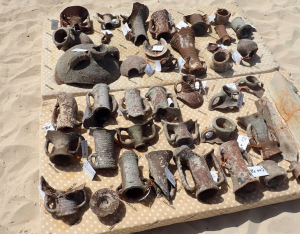
With the kind support of the HFF, the Centre for Maritime Archaeology and Underwater Cultural Heritage of Alexandria University concluded its third season of fieldwork at the site of Marsa Bagoush during the period from the 1st to the 16th of September 2017.
The survey was carried out by a team of 22 graduate students from the Alexandria Centre for Maritime Archaeology & Underwater Cultural Heritage.
The site of Marsa Bagoush (ancient Zygris), was mentioned in the Stadiasmus Maris Magni of the Early Roman Period as an anchorage sites with access to fresh water; “From Leuce Acte (Ras El Hekma) to Zygris (Bagoush) 90 stadia (c. 17km); there is an islet; put into the place with it on your left; there is water in the sand”.
The objectives of the 2017 season were:
- to resume developing 3D models for the main areas that contain concentrations of archaeological remains within the bay of Marsa Bagoush.
- to raise amphorae samples to be studied and dated.
- to look for evidence for access to fresh water near the coastline.
- to look for archaeological remains outside the bay of Marsa Bagoush.
Hence, during the survey, the team resumed developing a 3D model using phorogrammetry for the archaeological remains within the bay and to the northeast of the rocky headland to the east of the bay. However, one of the two grinding stones which were found in the 2017 season could not be located.
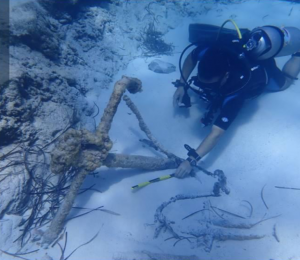
In addition to producing the 3D model of the seabed, a collection of 40 diagnostic amphora fragments were tagged and raised to the surface. The collection was chosen to cover all types of amphora found inside and outside the bay. The collection was then cleaned, documented, photographed, and placed back underwater in a deeper site outside the bay.
Based on the initial study of the amphora collection, the dating of amphorae range from the 3rd century BC (Zenon amphora from Knidos), until the 6th century AD (Late Roman 4 from Gaza). Accordingly, this is a clear indication that the site was a well-known anchorage during the Hellenistic and Roman periods. On the other hand, ceramic samples from what appears to be an Islamic medieval shipwreck were collected for more precise dating. However initial study of some ceramic objects indicates a date of the 12th – 14th century AD. Yet, more studies are to be carried out before a precise date and origin could be identified.
The survey also extended westwards where another bay existed 2.5km to the west of Bagoush. The bay of Abu Hashafa (ancient Ladamantia) was also mentioned in the Stadiasmus Maris Magni and described of having a rather large island and a harbour accessible with any wind. Accordingly, the northern part of the bay was surveyed by a team of four divers. Hence, the survey resulted in the discovery of two 19th century Admiralty anchors in addition to several metal remains of a shipwreck. However, the rest of the bay is yet to be surveyed in coming seasons.
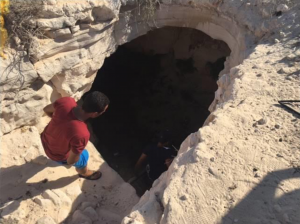
On the other hand, a survey was carried out on-land to the south of the shoreline. It covered an area of 1.5km2. The survey resulted in the discovery of a series of interconnected rock-cut cisterns c 400m south of the shoreline. At least three separate cistern systems were discovered. The cisterns were at a depth of 4m below ground level, while their depth was c.2m. They ranged in length from 11m to 40m. The cisterns probably date to the Early Roman period based on their style. However, it was noticed that the cisterns still had water which is currently being used by the locals for irrigation.
A 4D photogrammetry model of one of the cistern systems was developed. However, in the coming seasons the cisterns will be scanned using a laser scanner to develop an accurate plan of their design and extent. Extending the survey southwards, it was noticed that several areas were covered with ceramic sherds. Moreover, further to the south, at a distance of c. 2km from the coastline a typical Hellenistic / Early Roman rock cut tomb was found. The tomb contained eight rock cut burial loculi. The locals informed us of the existence of more tombs in the vicinity; however we were unable to locate them. The existence of tombs indicates the possible existence of a residential area in the region probably in the vicinity of the fresh water sources. A more detailed investigation or the area between the water sources and the tombs will be carried out next season.
Another indication for the significance of the Marsa Bagoush site was the discovery of several WWII fortifications c. 780m south of the coastline. The buildings were associated with airplane runway of which remains can still be seen. Initial research revealed that the site of Marsa Bagoush was a major transit camp for Royal Air Force during WWII, and in 1941 it was the base of No. 113 Squadron RAF. Probably this was also associated with the existence of fresh water sources in Bagoush.
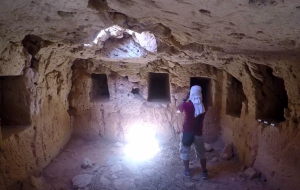
Future work:
- During the coming season, excavation of some silted spots inside the bay will be conducted using water dredges in order to expose and record the buried remains.
- Fabric analyses of ceramic samples will be carried out to determine its clay type and hence its exact origin.
- Also samples of the wooden fragments which were founds in the bay will be collected for dendro dating.
- The underwater survey will also extend to the north and west of Bagoush to record any archaeological remains.
- The interior of the cistern systems and the tombs will be scanned using a laser scanner.
- Finally, a management plan of the site will be developed with the objective of preserving its remains in situ and utilizing the site as a training facility for underwater archaeology.
 The project aims to conduct a thorough systematic survey of the ancient anchorage site of Marsa Bagoush, c.250km west of Alexandria. The site was mentioned by ancient authors of the 1st and 3rd centuries AD as one of the main anchorages along the northwest coast of Egypt. Hence, the project, which started in 2015, resulted so far in the discovery of evidence for ancient ships that date from the 3rd century BC until the 19th century. The discovered remains included anchors, ceramics, wooden fragments and roof tiles from ancient shipwrecks, in addition to a wealth of evidence for human occupation on land.
The project aims to conduct a thorough systematic survey of the ancient anchorage site of Marsa Bagoush, c.250km west of Alexandria. The site was mentioned by ancient authors of the 1st and 3rd centuries AD as one of the main anchorages along the northwest coast of Egypt. Hence, the project, which started in 2015, resulted so far in the discovery of evidence for ancient ships that date from the 3rd century BC until the 19th century. The discovered remains included anchors, ceramics, wooden fragments and roof tiles from ancient shipwrecks, in addition to a wealth of evidence for human occupation on land.
 During the 2018 season, the team shifted the focus of the survey further to the western side of the bay of Marsa Bagoush, where ancient sources such as Stadiasmus Maris Magni placed the ancient harbour of Ladamantia. The western side of the Marsa Bagoush is the most protected and most suitable for anchoring, so it is expected that ancient maritime activities would have been more intense there. On the other hand, it was noticeable that when the Stadiasmus Maris Magni mentioned the eastern part of Bagoush (Zygris), it was called described as an “anchorage”, while when it mentioned the western part of the bay (Ladamantia), it was a described as a “harbour”, which could reflect the particular importance of that site. Hence, during this season, a general survey of Ladamantia was conducted, during which 43 dives were carried out at depths ranging from 3m to 16m.
During the 2018 season, the team shifted the focus of the survey further to the western side of the bay of Marsa Bagoush, where ancient sources such as Stadiasmus Maris Magni placed the ancient harbour of Ladamantia. The western side of the Marsa Bagoush is the most protected and most suitable for anchoring, so it is expected that ancient maritime activities would have been more intense there. On the other hand, it was noticeable that when the Stadiasmus Maris Magni mentioned the eastern part of Bagoush (Zygris), it was called described as an “anchorage”, while when it mentioned the western part of the bay (Ladamantia), it was a described as a “harbour”, which could reflect the particular importance of that site. Hence, during this season, a general survey of Ladamantia was conducted, during which 43 dives were carried out at depths ranging from 3m to 16m.
The survey resulted in the following:
- The discovery of evidence for at least 12 anchors of different types and dates including lead stocks, lead collars, iron stocks and iron flukes. The date of these ranged from the Hellenistic Period to the 19th century. The site thus contains the largest collection of ancient anchors in any underwater site in Egypt outside Alexandria.
- In addition to the above, the site began to reveal, for the first time, intact amphora at depths between 12 meters to 16 meters. Eight different types of amphorae have been recorded from the Roman period originating from Egypt, Tunisia, Mauritania, Gaza, Rhodes, and Aegean. Moreover, many clusters of pottery sherds belonging to various types of amphorae were discovered, the most significant of which are Amphore Égyptienne 3 and Amphore Égyptienne 4, both of which were manufactured in Egypt and specifically in the Mareotic region from the 1st to the 3rd centuries AD. Hence, the ship that was carrying those amphorae probably left Alexandria on its way to one of the Mediterranean ports laden with Egyptian wine produced in the Mareotic region. The Amphore Égyptienne 3 is one of the most important types that was produced exclusively in Egypt from the 1st to the 4th century AD.
- Moreover, among the items that were discovered in the site for the first time are lead brail rings. Two have so far been identified, each of a diameter of about 7 cm. Also several iron nails and fragments of wood were discovered representing evidence for wooden sailing ships.
Planning these remains on a map indicated that they cover an area of 500m x 250m. It is likely that the area was the route of ships entering and leaving the harbour to avoid the shallow rocks to the north and west of the harbour entrance.

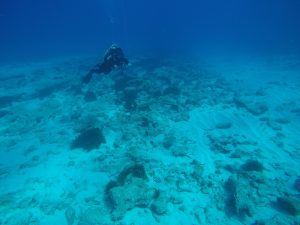
The 2019 fieldwork season took place from the 7th to the 17th of March. It was the first time that we work during that time of the year. However, because the security permissions were about to expire at the end of March, we carried out this short season to explore some areas at the western side of the Marsa Bagoush bay and to confirm the types and dates of the intact amphorae that we plan to raise during the 2020 season.
It is evident from ancient text that the western bay of Bagoush was accessible in any wind, as mentioned in the Stadiasmus Maris Magni, and that is was considered to be a safe anchorage form ships of any size. This was confirmed by the archaeological evidence discovered so far at the site.
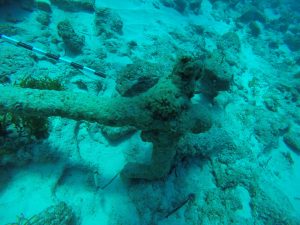 During this season, 26 dives were made to depths between 3 to 16 meters. Ten more ancient anchors were discovered and recorded, including lead stocks and iron anchors of different forms. That brings the total number of anchors discovered and recorded in the western side of the Marsa Bagoush bay to more than 20 anchors, mostly from the Roman period.
During this season, 26 dives were made to depths between 3 to 16 meters. Ten more ancient anchors were discovered and recorded, including lead stocks and iron anchors of different forms. That brings the total number of anchors discovered and recorded in the western side of the Marsa Bagoush bay to more than 20 anchors, mostly from the Roman period.
So far, the site of Marsa Bagoush has revealed more anchors of different types and dates than any other site along the north coast of Egypt, except Alexandria. That give an indication on the intense and extent of maritime traffic that was going through Bagoush during the past two millenia.
In addition to the anchors, the site also revealed, for the first time, some wooden planking with iron nails in it, as well as some roof tiles. This could be an indication of a possible shipwreck close to the middle of the bay.
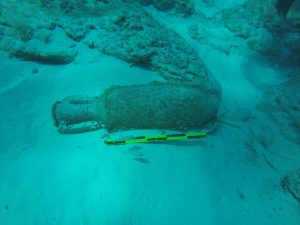 On the other hand, in addition to the Egyptian Roman amphorae that were recorded in previous seasons, during this season, several imported amphorae were discovered. That included Rhodian and Knidian amphorae from the Hellenistic period. Accordingly, the site contains evidence for ships carrying Egyptian products to other regions in the Mediterranean as well as ships carrying north African and Aegean wine amphorae into Egypt.
On the other hand, in addition to the Egyptian Roman amphorae that were recorded in previous seasons, during this season, several imported amphorae were discovered. That included Rhodian and Knidian amphorae from the Hellenistic period. Accordingly, the site contains evidence for ships carrying Egyptian products to other regions in the Mediterranean as well as ships carrying north African and Aegean wine amphorae into Egypt.
The discovered archaeological material was recorded, and photographed. Also a photogrammetry 3D model was developed for the anchors. We are aiming to develop a database of the anchors found in Marsa Bagoush by the end of the project.
 During the 2020 survey, the western part of Bagoush bay was divided into sections using SMBs and each section was surveyed thoroughly by teams of divers. Once archaeological material was located, an SMB was deployed to the surface so that the location was marked by GPS on the support vessel. Hence, each recorded site was photographed and documented using photogrammetry.The 2020 season ran from the 10 of June to the 22nd of June 2020. During that time 55 dives were made.
During the 2020 survey, the western part of Bagoush bay was divided into sections using SMBs and each section was surveyed thoroughly by teams of divers. Once archaeological material was located, an SMB was deployed to the surface so that the location was marked by GPS on the support vessel. Hence, each recorded site was photographed and documented using photogrammetry.The 2020 season ran from the 10 of June to the 22nd of June 2020. During that time 55 dives were made.
The recorded archaeological remains were divided into several categories:
1- Concentrations of ceramic clusters (including broken amphora and coarse ware),
2- Individual intact amphorae
3- Ancient anchors of different forms and dates.
So far, more than 30 anchors were recorded on the site. They varied between stone anchors, lead stock anchors and iron anchors, mostly dating to the Roman period, several of them are mostly intact. Each anchor was then tagged, recorded and photographed.
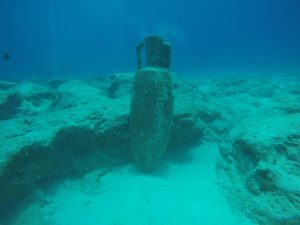 On the other hand, we were asked by the Ministry of Tourism and Antiquities to recover amphora from each type discovered, to be exhibited at the Alexandria Graeco-Roman Museum. Accordingly, seven amphorae from seven different types were excavated and transported to Alexandria for conservation.
On the other hand, we were asked by the Ministry of Tourism and Antiquities to recover amphora from each type discovered, to be exhibited at the Alexandria Graeco-Roman Museum. Accordingly, seven amphorae from seven different types were excavated and transported to Alexandria for conservation.
The excavated amphora types are:
1- AE4 Early Roman amphora (Egypt)
2- AE3 Early Roman amphora (Egypt)
3- LR1 Late Roman amphora (Cyprus)
4- LR4 Late Roman amphora (Ghaza)
5- LR5/6 Late Roman amphora (Ghaza)
6- North African Cylindrical 4th-5th AD (Tunisia)
7- Agora K 109 – 3rd-4th AD (North Africa)
Based on the research carried out and on the distribution of the discovered archaeological remains, it is expected that more remains are located in the middle of the bay and in deeper water outside the bay, which we aim to survey in subsequent seasons.
Below is a short documentary of the 2020 fieldwork season.
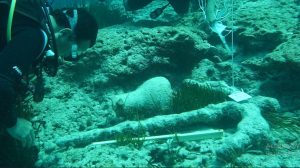 The 2021 season took place from the 4th – 18th June 2021 and focused on Ladamantia, where several ancient anchors have been previously recorded. This year, the survey covered an area of c. 400,000 square meters, where archaeological material was recorded and documented. So far, 45 ancient anchors have been recorded in Ladamantia, which is the largest number of anchors to be found in Egypt outside Alexandria. Moreover, evidence for at least two shipwrecks was discovered so far, which will require more detailed investigation in the coming seasons.
The 2021 season took place from the 4th – 18th June 2021 and focused on Ladamantia, where several ancient anchors have been previously recorded. This year, the survey covered an area of c. 400,000 square meters, where archaeological material was recorded and documented. So far, 45 ancient anchors have been recorded in Ladamantia, which is the largest number of anchors to be found in Egypt outside Alexandria. Moreover, evidence for at least two shipwrecks was discovered so far, which will require more detailed investigation in the coming seasons.
During this season, a GIS-based map was developed for the survey area. The area was divided into 330 100m X 100m square grids, which would help ensure full coverage of the area. On the other hand, this year, surveying teams used a 50m survey line, which was held underwater by 4 – 5 divers with overlapping visibility to make sure that each square was covered thoroughly. The team was divided into two groups. The squares that were surveyed in previous seasons were rechecked by a group of divers, and surveying new squares were carried out by another group simultaneously. A total of 71 dives were carried out during the season, during which all newly discovered anchors were tagged, photographed and their locations were recorded using a GPS. The GPS was attached to a Surface Marker Buoy held by a diver within the group so that it was tracking the dive’s route. On the other hand, GPS locations were also taken at the surface by the supporting vessel following the SMB.
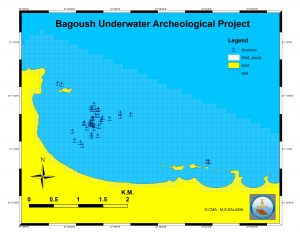 In addition to the 28 anchors that were previously recorded at the site, 17 more anchors were recorded in 2021, which brings the total number of anchors discovered at the site to 45, which included 33 Roman iron anchors of different types, 10 lead anchors, 1 stone anchor, in addition to 2 early 20th-century British Admiralty anchors. Moreover, in two particular sites, large concentrations of amphora sherds were located within the context of thick seagrass mounds, which could indicate the existence of shipwreck remains under the seagrass mounds.
In addition to the 28 anchors that were previously recorded at the site, 17 more anchors were recorded in 2021, which brings the total number of anchors discovered at the site to 45, which included 33 Roman iron anchors of different types, 10 lead anchors, 1 stone anchor, in addition to 2 early 20th-century British Admiralty anchors. Moreover, in two particular sites, large concentrations of amphora sherds were located within the context of thick seagrass mounds, which could indicate the existence of shipwreck remains under the seagrass mounds.
The survey extended eastward to cover an area of c.50,000 m2, and southward to cover an area of c.90,000m2. to a depth of 21m, which is the maximum depth to be recorded on the site so far. Photogrammetry documentation was carried out for particular areas according to their significance. One particular area contained a stone anchor, two lead stock anchors, and a sounding lead in close proximity, in an area of c. 40m2. It is worth mentioning that this is the first sounding lead to be found on the site.
